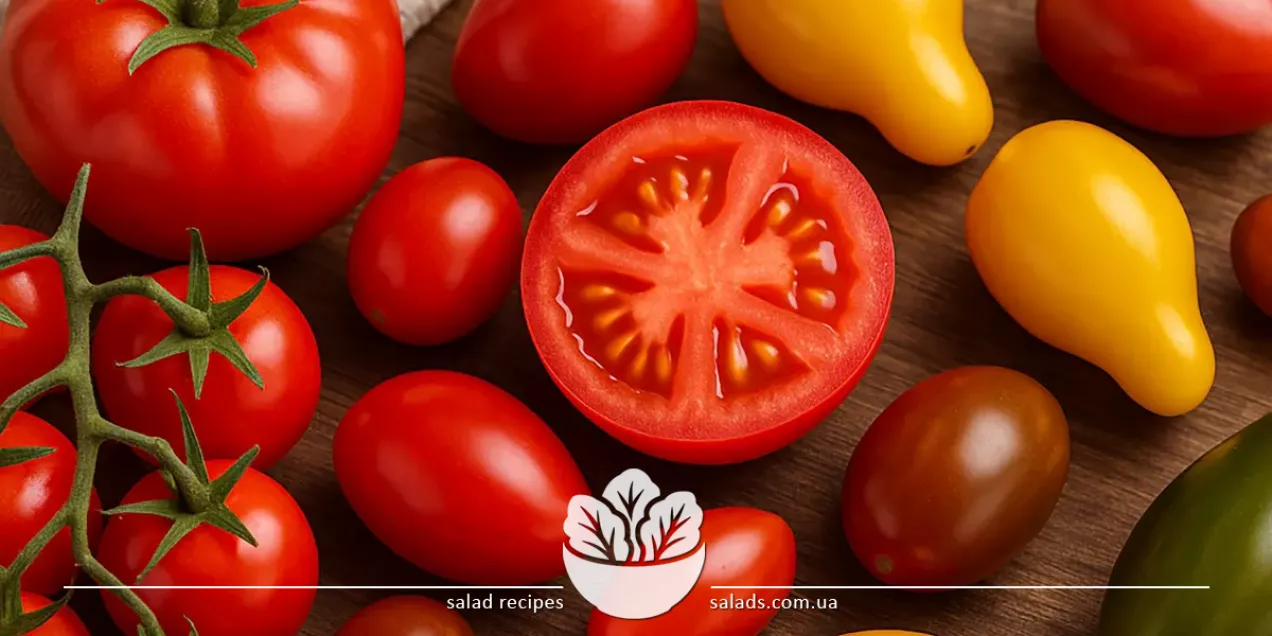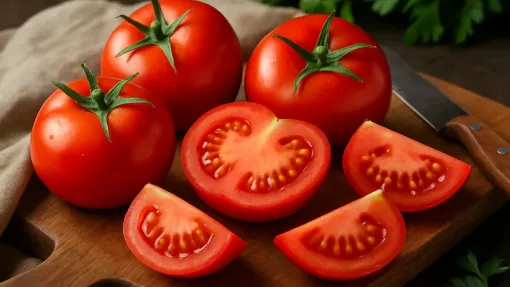Types of Tomatoes

Types of tomatoes offer a broad spectrum of taste, color, and texture, allowing this vegetable to be used in a wide range of culinary styles. There are varieties for salads, sauces, baking, stewing, and preserving. They differ in size, shape, pulp color, skin thickness, and sugar level. Tomatoes may be sweet, sweet and tangy, or meaty and dense. They are added to appetizers, main courses, and soups, either fresh or cooked. Learn more about vegetable ingredients in the vegetables category.
Different Types of Tomatoes
Popular Tomato Varieties and Their Culinary Properties
Tomatoes come in a wide range of types, each with its own culinary use. The most well-known are the classic round red tomatoes, suitable for universal use: in salads, hot dishes, sauces, and preserves. They offer a balanced flavor and moderate juiciness, making them ideal for combining with other ingredients and for cooking. Cherry tomatoes are small and round with a pronounced sweetness and crisp texture. They are often served whole in salads, added to sandwiches, baked on the vine, or preserved as appetizers. They hold their shape well even after roasting, making them popular in Mediterranean-style dishes. Plum tomatoes have an elongated shape and dense flesh. They are ideal for sauces, as they contain few seeds and a high amount of solids. When cooked, they retain their consistency rather than falling apart, which is important for pasta sauce or pizza toppings.
Pink tomatoes are known for their sweet flavor and meaty texture. They are especially popular for salads that require large, juicy chunks that won’t fall apart and have a rich taste. Yellow, orange, and green tomatoes tend to have a milder, less acidic profile, sometimes with fruity notes, and are often used to create colorful combinations in dishes. Various tomato types are often mixed in a single recipe. For instance, salads may combine cherry and large pink tomatoes, along with other seasonal vegetables such as cucumbers to create a contrast in texture and flavor balance.
Tomatoes in Salads, Appetizers, and Sandwiches
Fresh tomatoes are a key component in many cold dishes. In salads, they play an essential role due to their juiciness, acidity, and color variety. A classic combination includes tomatoes with cucumbers, onions, herbs, and a light dressing of oil or sour cream. Such a salad requires no complex ingredients and always complements a main dish. Cherry or cocktail tomatoes are often used whole or halved – they add sweetness and maintain their shape well. Tomato-based appetizers are also widely used in cooking. They are layered on bread slices with cheese, herbs, butter, or garlic to create simple yet flavorful bruschettas. Tomatoes are also featured in canapés, tartlets, mini rolls, and vegetable pâtés. When paired with soft cheeses like mozzarella, feta, or cream cheese, they offer an ideal balance of texture and taste.
In sandwiches, tomatoes serve multiple functions: they add juiciness, enhance the flavor of meat or cheese, and brighten the appearance of the dish. Pink varieties are particularly appreciated – they are meaty and don’t “leak,” making them easy to slice and arrange on bread. Cherry tomatoes are great for mini sandwiches or lunchboxes. To add contrast, tomatoes are often combined with sweet peppers. This pairing enhances flavor intensity and introduces texture variation in salads or appetizers. Both vegetables pair well with herbs, cheese, eggs, and other summer ingredients.
Tomatoes in Hot Dishes and Sauces
Tomatoes are one of the few vegetables that enhance their flavor when cooked. That’s why they are widely used in hot dishes – either as a main ingredient or as an addition. In vegetable stews, meat sauces, braises, and casseroles, they provide juiciness, softness, and an acidic balance. Tomatoes soften quickly during cooking, transforming into a thick, flavorful base that ties the ingredients together. Tomato sauces are a category of their own. Plum varieties are most often used for these – they are denser, contain less juice and fewer seeds, and easily form a smooth purée. A tomato sauce may be basic – with onions, garlic, and spices – or more complex, with olives, capers, anchovies, wine, or cream. Such sauces are used for pasta, lasagna, baked vegetables, or meat.
Tomatoes are also essential in dishes like pizza, shakshuka, ratatouille, sautéed vegetables, and lecsó. They are baked whole or halved, used as filling for pies, or stuffed with other ingredients. In combination with eggplants, zucchini, peppers, and herbs, tomatoes create rich vegetable dishes that retain flavor even after long cooking. Tomatoes are most often paired with garlic in sauces – this duo adds depth, aroma, and a spicy kick. Garlic intensifies the sweet and tangy profile of tomatoes and enriches their taste, especially in Mediterranean, Georgian, or Latin American cuisine.
Tomato Preserving: Classic Methods and Variations
Tomatoes are one of the most convenient vegetables to preserve. They can be stored whole, in sauces, marinades, pickles, or as paste. The simplest method is canning whole tomatoes in their own juice with minimal seasoning. This allows the flavor and texture of tomatoes – particularly dense plum varieties – to be retained. Pickled tomatoes are a traditional preserve found in many regions. They are canned with vinegar, sugar, salt, pepper, herbs, garlic, and onions. Such tomatoes may be sweet and sour, spicy, or mild – depending on the recipe. They are used as appetizers, side dishes, or salad ingredients. Cherry tomatoes are especially popular for pickling – their firm skins and small size help them retain a crunch even after processing.
Tomato paste and juice are another way to preserve the harvest. Tomatoes are peeled, puréed, and simmered to the desired consistency. Paste has a concentrated flavor and is used in sauces, gravies, and soups. Tomato juice, especially homemade, is often prepared with minimal salt and served as a beverage or as a base for hot dishes. Some recipes use semi-dried tomatoes – dehydrated in the oven or a food dryer, sometimes with herbs, spices, and olive oil. These tomatoes offer a rich taste and aroma and are perfect for pasta, salads, or sandwiches. In mixed preserves, tomatoes are often combined with eggplants, peppers, and carrots – as in lecsó, adjika, vegetable purées, or sautés.
How to Choose, Store, and Use Tomatoes
To get the best flavor from tomatoes, it’s important to choose them correctly. For salads, pink, meaty varieties with thin skin and rich taste are best. If cooking or making sauce, dense plum tomatoes are ideal. Cherry tomatoes are perfect for fresh presentation, baking, or pickling. Avoid fruits with cracks, dents, or excessive softness – these are signs of overripeness or spoilage. Tomatoes are best stored at room temperature, especially if not fully ripe. In the fridge, they can lose aroma and become watery. It’s best to keep them in a basket or crate in a shaded place. To extend shelf life, choose underripe tomatoes and let them ripen gradually. Tomatoes intended for cooking can be stored in a cool, but not cold, location.
Before use, rinse tomatoes under running water. If the skin needs to be removed, it peels off easily after a short blanching in boiling water. In salads, tomatoes are sliced, halved, or diced depending on the desired texture. In sauces and soups, they are often puréed or blended until smooth. Tomatoes combine easily with a wide range of ingredients – vegetables, spices, herbs, meat, and cheese. One of the best pairings for fresh tomatoes is onion. It highlights the sweet and tangy profile of tomatoes and adds pungency and aroma. This combination is used in salads, sauces, marinades, or vegetable sides. When chosen and prepared correctly, tomatoes become not just a supplement but a key flavor highlight in many dishes.
